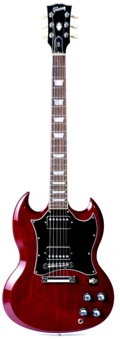 Davis Guggenheim will be bringing us a cool doc about the electric guitar and its relationship to the one that wields it. We get wind of this project thanks to the professionals at Variety:
Davis Guggenheim will be bringing us a cool doc about the electric guitar and its relationship to the one that wields it. We get wind of this project thanks to the professionals at Variety:
Davis Guggenheim has completed filming on a documentary that will look at the story of the electric guitar from the point of view of three significant rock musicians: the Edge, Jimmy Page and Jack White.
.Led Zeppelin’s Page, U2’s the Edge and White, leader of the White Stripes and the Raconteurs, were chosen for their impact across three different generations — from Page’s 1960s days as a session musician and a member of the Yardbirds into the Edge’s unique sound developed in the ’80s through White’s current work. Each explains and demonstrates how he changed the sound of the electric guitar to suit his own style. Pic includes a jam session featuring the three guitarists.
Those that play the electric guitar know the nuances of their tone. In my own life I have journeyed to find the best electric baritone ukulele sound. Since discussion about this subject is limited, I had to do much of the research myself, in order to find a sound that I was pleased with.
I commissioned master smith Fred Gabrsek to create a legendary semi-hollow electric ukulele using a mahogany body and neck, sepele topwood, ebony fingerboard, rosewood bridge, bone nut, tusq saddle, and fishman transducer pickup. Fred quite literally made the instrument of my dreams from a few scribbles I made on paper, ongoing discussion and a cardboard template I cut from a pizza box.
A few amplifiers were tried, a Traynor YBA-1 Bassmaster was used for years, then modified to sound more like a Fender Bassman. 50 watts was always too loud, and I couldn’t get the full amp saturation that I wanted, so I bought a small Epiphone Valve Jr. and had Rose City amp guru Glen Morris mod it with a point to point wired circuit. While he was doing that. I had the chance to play my uke through a few of his amps – and it sounded fantastic through his Morris Muscle 14 amplifier.
Glen was nice enough to give me a deal on the amp, the 14 watts is plenty loud for a solo performer, and the tone was perfect. In the signal chain I always use a Boss CS-3 Compression Pedal (with monte allums mod) to smooth out the sound of the (Aquila Nylgut) nylon strings and a BBE sonic maximizer to sweeten & fatten up the tone. For additional distortion I will use my superior Big Muff clone (Ron Sound Hairpie) and have a vintage Japanese Boss DD-2 for delays. My uke sound is finally where I want it, and the journey took about 10 years.
All of this may be mumbo jumbo to many of you, but to those that like to play electric instruments; tone is of supreme importance. Even for casual players like myself, you want to have your sound “just right”. If I would go to all this trouble to work on my sound, imagine the tales these professionals will spin about their journeys! If you hear the guitar of Jimmy Page, The Edge, Or Jack White – you know who it is; from a single note. Tone is a distinctive fingerprint that you are able to create for yourself.
I think this is an outstanding idea for a documentary and I welcome the work of Guggenheim.






Interesting ideas… I wonder how the Hollywood media would portray this?
Fred Gabrsek is not a “master smith”….he’s a “maestro smythe”
i really need to start proof reading my posts….that one doesn’t even make sense.
I cant wait to see this. I am in love with guitar.
The Edge is God.
being something of a tone nazi myself, i will probbaly watch it.
even if i do edge and white are overrated.